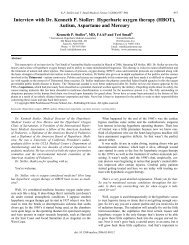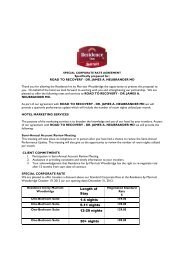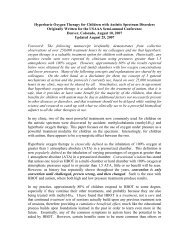Interview with Dr - Dr. Neubrander
Interview with Dr - Dr. Neubrander
Interview with Dr - Dr. Neubrander
You also want an ePaper? Increase the reach of your titles
YUMPU automatically turns print PDFs into web optimized ePapers that Google loves.
950<br />
D.A. Rossignol and T. Small/Medical Veritas 3 (2006) 944–951<br />
What were the patients’ ages and levels of affect of autism<br />
The age range was 2-7. Three had CARS score below 30<br />
(which technically is below the cutoff for a diagnosis of autism,<br />
but these children had received many of the DAN! protocols<br />
over the years and had already had a lot of improvements) and 3<br />
were in the moderate to severe category.<br />
All had regressed<br />
I think all but one had regressed.<br />
Were the children taking anti-oxidants<br />
All of the children were following standard DAN! protocol<br />
and so were already taking multiple antioxidants.<br />
Was HBOT the only therapy added or deleted<br />
HBOT was added to the regimen but parents were allowed<br />
to make other changes. This was not a prospective study but<br />
rather a retrospective analysis. Scales were filled out before and<br />
after treatment by the parents and then reviewed at a later date.<br />
Even though some parents did add other treatments from time<br />
to time during the study, none of the parents reported their child<br />
as undergoing developmental spurts of similar or greater magnitude<br />
in the recent past as was seen <strong>with</strong> HBOT.<br />
Which pre- and post-assessments were used<br />
We used three scales: ATEC (Autism Treatment Evaluation<br />
Checklist), CARS (Childhood Autism Rating Scale) and SRS<br />
(Social Responsiveness Scale).. ATEC is a scoring system of<br />
verbal communication, sociability, sensory/cognitive awareness,<br />
and health/autistic behaviors published by the Autism<br />
Research Institute. CARS is a widely used scale for screening<br />
and diagnosing autism and has been shown to correlate very<br />
well <strong>with</strong> the DSM-IV criteria for autism diagnosis. SRS is a<br />
recently validated test of interpersonal behavior, communication,<br />
and stereotypical traits in autism.<br />
What were the results And what were the most notable<br />
findings of your study<br />
ATEC improved 22.1 % overall <strong>with</strong> a p value of 0.0538.<br />
CARS improved 12.1 % overall (p = 0.0178)<br />
SRS improved 22.1% overall (p = 0.0518).<br />
I think the most notable finding was that the 3 youngest (less<br />
than age 5) improved more dramatically than the 3 oldest:<br />
ATEC 31.6% vs. 8.8%<br />
CARS 18.0% vs. 5.6%<br />
SRS 28.9% vs. 13.0%<br />
It must be noted that these results in the younger children compared<br />
to the older children were not statistically significant due<br />
to the small sample size.<br />
Might higher pressure and 100% oxygen have had an even<br />
greater positive effect<br />
Maybe and probably. In this case series, the chamber was<br />
augmented <strong>with</strong> only 28% oxygen instead of 100% oxygen.<br />
Anecdotal reports from other DAN physicians seem to indicate<br />
that some children have more improvement more quickly <strong>with</strong><br />
higher pressure and 100% oxygen. Every child is different and<br />
some seem to respond quickly to lower pressure and oxygen<br />
levels and some appear to need higher pressures and oxygen<br />
levels. I think it makes sense to use to the lowest amount of<br />
oxygen and pressure that gets the job done. Where this is for<br />
each patient may be tricky to discover initially. Certainly, further<br />
studies on this are needed.<br />
Is there any trend becoming evident insofar as optimal number<br />
of treatments, degree of pressure, optimal age, or some<br />
permutation of these factors<br />
The number of HBOT sessions needed to produce full clinical<br />
improvements from cerebral hypoperfusion or ischemia is<br />
unclear. In one study combining the use of SPECT and HBOT,<br />
an average of 70 treatments was needed to show a significant<br />
increase in cerebral blood oxygenation and metabolism in patients<br />
<strong>with</strong> chronic neurological disorders including CP, stroke,<br />
and traumatic brain injury. Of note, the rate of improvement in<br />
cerebral blood oxygenation was more profound during the last<br />
35 treatments compared to the first 35. In addition, reports from<br />
some HBOT researchers indicate that younger patients tend to<br />
have improvements more quickly than older patients, as also<br />
seen in our small case series. Therefore, older patients may<br />
need more treatments.<br />
Why would younger children improve more readily<br />
As I said, the interesting finding from this case series was<br />
that the younger children had more significant improvements in<br />
clinical outcome scores than the older children. This is congruent<br />
<strong>with</strong> reports from some HBOT researchers indicating that<br />
younger patients tend to have improvements more quickly than<br />
older patients. The younger children in this case series may<br />
have had less overall hypoperfusion to surmount because decreased<br />
cerebral blood flow to areas associated <strong>with</strong> communication<br />
has been shown to worsen <strong>with</strong> increasing age in autistic<br />
children as we discussed earlier. It is likely that the older children<br />
in this case series need more than 40 HBOT sessions to<br />
show further improvements, especially since some HBOT researchers<br />
have noted that 50-80 HBOT sessions are typically<br />
needed to show significant clinical gains.<br />
So what would be the procedure to do 50-80 hours of<br />
HBOT Do different pressures or masks & hoods and different<br />
concentration of oxygen require you to take breaks at different<br />
points in treatment How many hours per day Days per week<br />
Weeks to take a break And so on…<br />
.<br />
Most researchers recommend 40 treatments over 8 weeks<br />
which is 5 treatments per week <strong>with</strong> the weekends off. As far as<br />
I am aware, there is no magic to this number but it was rather<br />
chosen for convenience as a lot of people have to travel out of<br />
town to do treatments. Most then recommend a break of 1-2<br />
months before another 40 treatments. Some people will do 2<br />
doi: 10.1588/medver.2006.03.00110





